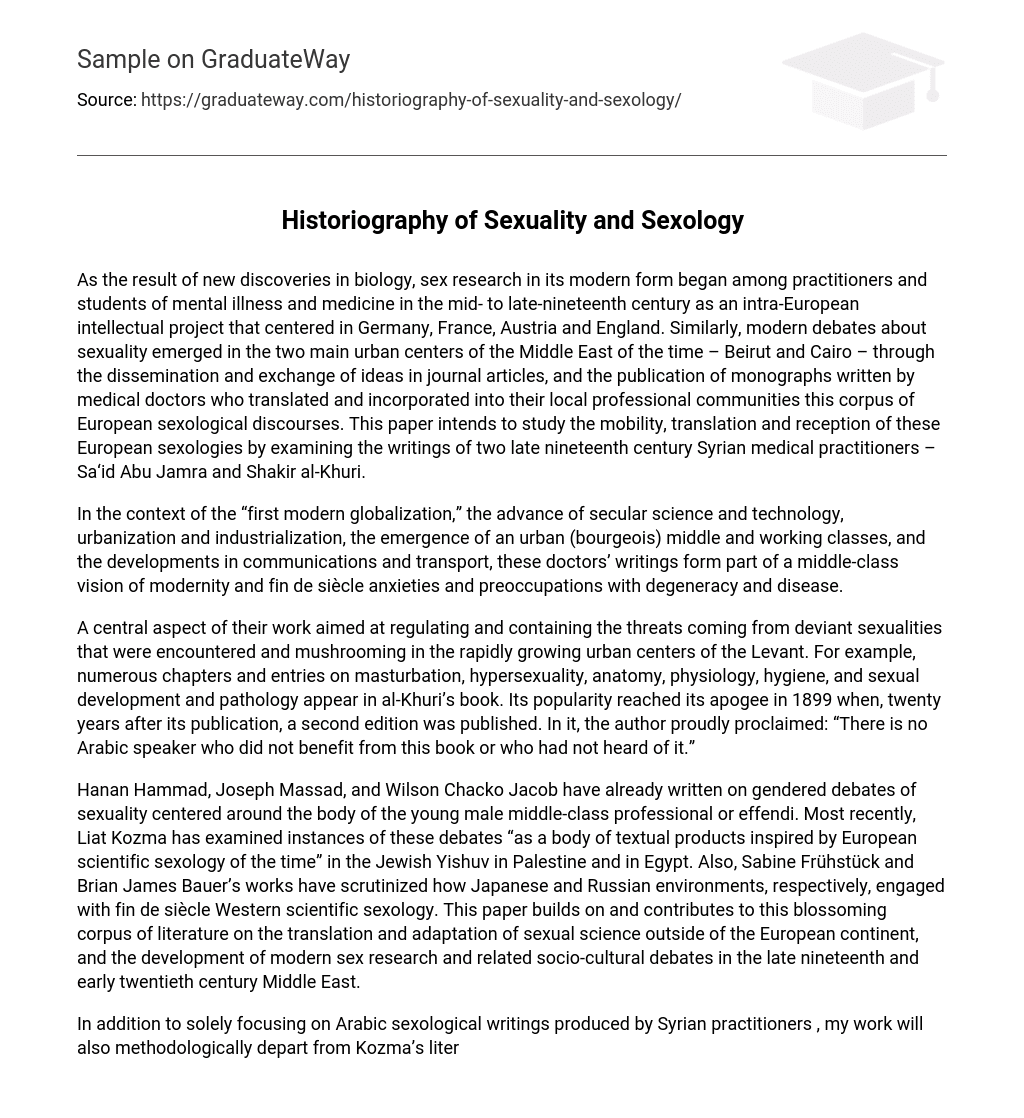As the result of new discoveries in biology, sex research in its modern form began among practitioners and students of mental illness and medicine in the mid- to late-nineteenth century as an intra-European intellectual project that centered in Germany, France, Austria and England. Similarly, modern debates about sexuality emerged in the two main urban centers of the Middle East of the time – Beirut and Cairo – through the dissemination and exchange of ideas in journal articles, and the publication of monographs written by medical doctors who translated and incorporated into their local professional communities this corpus of European sexological discourses. This paper intends to study the mobility, translation and reception of these European sexologies by examining the writings of two late nineteenth century Syrian medical practitioners – Sa‘id Abu Jamra and Shakir al-Khuri.
In the context of the “first modern globalization,” the advance of secular science and technology, urbanization and industrialization, the emergence of an urban (bourgeois) middle and working classes, and the developments in communications and transport, these doctors’ writings form part of a middle-class vision of modernity and fin de siècle anxieties and preoccupations with degeneracy and disease.
A central aspect of their work aimed at regulating and containing the threats coming from deviant sexualities that were encountered and mushrooming in the rapidly growing urban centers of the Levant. For example, numerous chapters and entries on masturbation, hypersexuality, anatomy, physiology, hygiene, and sexual development and pathology appear in al-Khuri’s book. Its popularity reached its apogee in 1899 when, twenty years after its publication, a second edition was published. In it, the author proudly proclaimed: “There is no Arabic speaker who did not benefit from this book or who had not heard of it.”
Hanan Hammad, Joseph Massad, and Wilson Chacko Jacob have already written on gendered debates of sexuality centered around the body of the young male middle-class professional or effendi. Most recently, Liat Kozma has examined instances of these debates “as a body of textual products inspired by European scientific sexology of the time” in the Jewish Yishuv in Palestine and in Egypt. Also, Sabine Frühstück and Brian James Bauer’s works have scrutinized how Japanese and Russian environments, respectively, engaged with fin de siècle Western scientific sexology. This paper builds on and contributes to this blossoming corpus of literature on the translation and adaptation of sexual science outside of the European continent, and the development of modern sex research and related socio-cultural debates in the late nineteenth and early twentieth century Middle East.
In addition to solely focusing on Arabic sexological writings produced by Syrian practitioners , my work will also methodologically depart from Kozma’s literature in that it will adopt a transnational framework in the study of the intersection between sexuality and modernity in the Levant. This paper will explore the limits and possibilities of studying a global history of sexuality through the examination of the proliferation of these sexological scholarships. It aims to shift the focus away from Europe and North America which have dominated the historiography of sexuality and sexology during the twentieth century.
Moreover, other than the two aforementioned doctors’ monographs, the paper will rely on letters and articles published in al-Muqtataf (The Digest), al-Hilal (The Crescent) and al-Jinan (The Gardens) – three popular Arabic periodicals that presented in their pages a tasteful amalgam of scientific, humanistic, and adapted or originally authored stories to their readership in Egypt and the Levant. So, not only did these journals offer their audiences advice columns and informative scientific and political articles but also, they featured “cheap love stories” that appeared in juxtaposition with discussions of sex, health and hygiene.
As such, a growing literate middle-class public in Beirut, Damascus, Alexandria and Cairo concurrently learned about modern understandings of romantic love, consumed these disciplinary sexological writings, and also, participated in these literary, scientific and political debates. Consequently, this work surveys the open traffic between science and culture and relations between specialists and lay people in the development of modern sexual politics.
Both abovementioned experts position themselves as harbingers of modernity and progress, and as social reformers advising their compatriots in notions of physical fitness, the improvement of middle-class bodies and the formation of normative family units. In doing so, they become new sources of authority playing a foundational role in the demarcation of contours between public and private spheres and the consolidation of the ever-growing consumer middle class of the new age (al-‘aṣr al-jadīd). In the Levantine context, this sort of “epochalism” became a potent social and moral tool employed by this class of bourgeois intellectuals who sidelined the practices of other non-conforming classes as antiquated and pre-modern superstitions and asserted themselves as “the vanguards of provincial modernity.”





